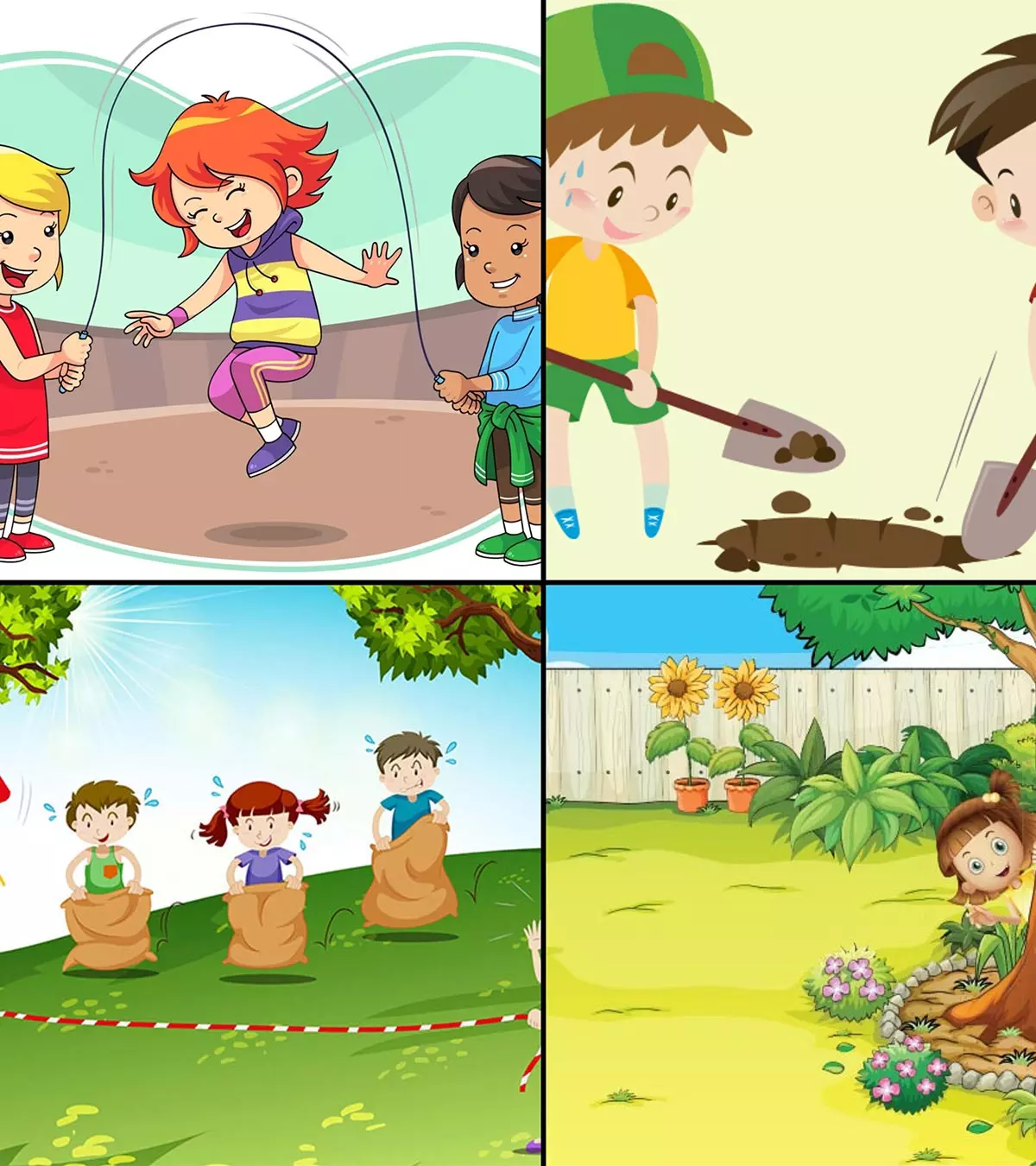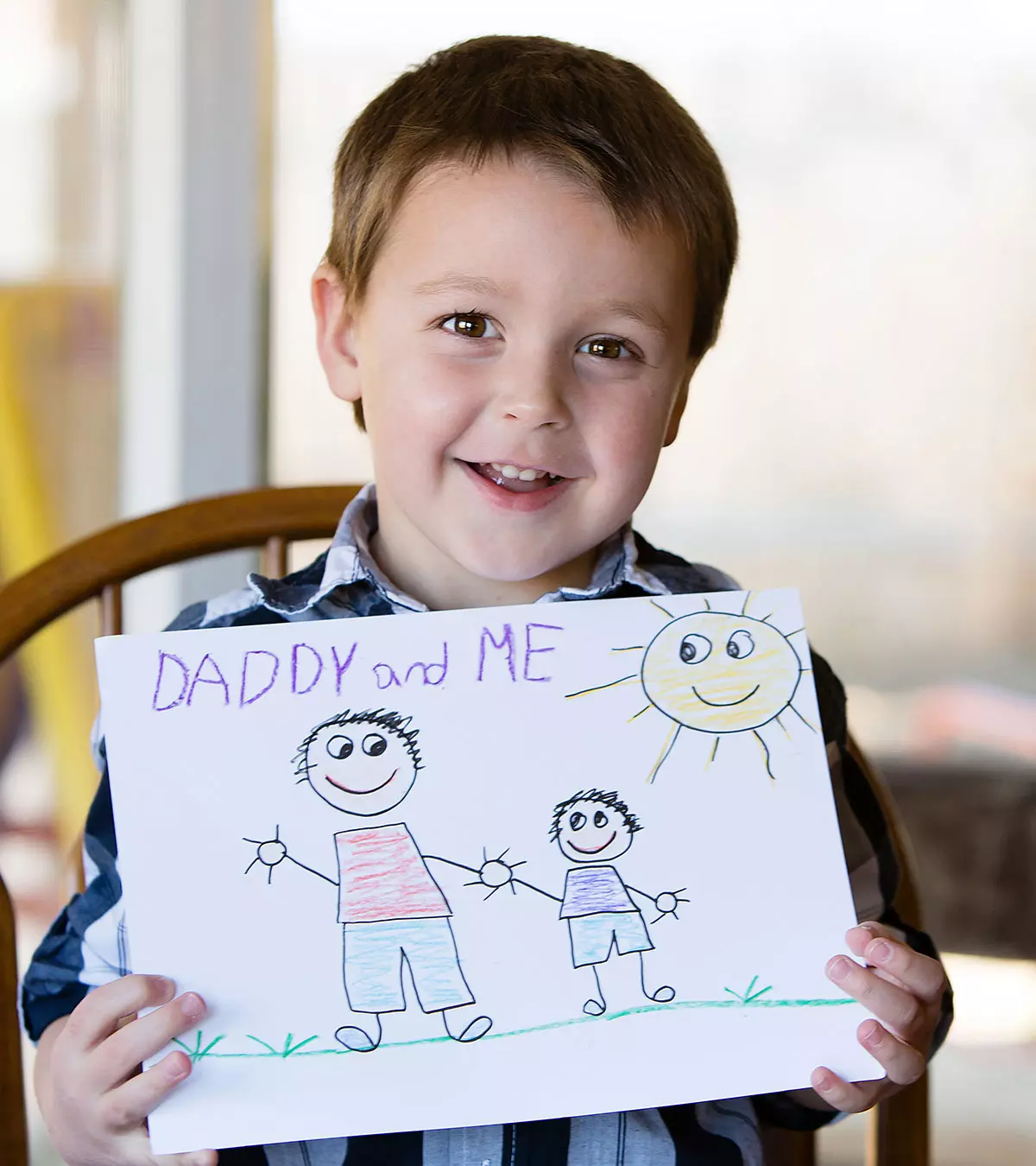
Image: Shutterstock
Swimming is an entertaining and great form of exercise for children. If you are wondering how to teach kids to swim, consider trying the tips given in this post. It is a crucial survival skill that reduces the possibility of your child drowning accidentally. Also, the activity enables your child to streamline their excess energy in a positive direction (1). At which age should you introduce swimming lessons and coaching to children, and what are some of the precautions you should take? Read on as we answer all these questions a parent may have before their child takes their first swimming lesson.
Key Pointers
- Children can start their swimming lessons when they are physically and emotionally ready for it.
- To ensure safety, constantly supervise the child while swimming and install safety equipment and fence around the pool.
- To make swimming enjoyable, allow them to explore the water independently, give them interesting swimming costumes, or play fun games.
- Always consider the age of a child while giving swimming lessons.
What Is The Best Age To Teach A Child To Swim?

The right age to teach a child to swim is dependent on several factors such as the physical and mental development of the child, their emotional readiness, their exposure to water, and their comfort. The rate of development may differ from child to child. As per the American Academy of Paediatrics, you could introduce swimming lessons to children when they are as young as four years old (1).
 Did you know?
Did you know?Pool Safety: Expert Guidelines

Most water-related deaths of children occur at swimming pools at home. To protect children from drowning in pools, follow these pool safety guidelines given by experts (1) (2) (3).
- A child should never be left unsupervised near the pool or a spa.
- Whenever children under five are in the pool area, they should be constantly supervised by an adult with complete knowledge of swimming and CPR. The adult should be present at arm’s length from the child.
- Ensure the child uses the necessary safety equipment, such as US Coast Guard approved life jackets or personal flotation devices. Also, keep your phone handy for emergencies.
- Avoid using inflatable aids such as water wings, swim rings, inflatable toys, and other items designed for water recreation, as they can easily slip off or deflate without warning. They also do not support their lower body, which can make the child tip forward and submerge their face in water.
- Keep tables and chairs away from the pool area to keep them from climbing into the pool. Always check the swimming pool if a child goes missing.
- The pool should have at least a four-foot high fence on all four sides to prevent the child from getting inside without supervision. There should not be any gaps or openings in the fence through which a child can pass through.
- The fence doors should have a self-latchingiA gate with a self locking mechanism and self-closing mechanism. The latch should be at enough height to ensure children cannot unlock it.
- Set up an alarm at the pool gate or the door separating the house and the pool. You could also use underwater alarms and surface wave alarms for added security.
- Even if you have an inflatable backyard pool, ensure it is surrounded by a fence.
- Make a safety post and keep a first aid kit handy at all times.
- Consult the Association of Pool and Spa Professionals when setting up pools, drains, or other pool add-ons.
How To Prepare A Child For Swimming?
Taking certain measures can help your child have fun and look forward to every new swimming session. An anonymous blogger from Singapore explains what she and her husband did before their child’s swimming lesson. She says. ”Before every lesson, Andrew (her husband) and I go through the list of things to do and not to do. For example, we talk about how he (her son) is supposed to sit on the top step of the pool until the teacher asks him to get down. We also talk about paying attention and listening to the teacher (i).” Here are some tips to prepare your little one for swimming.
1. Address their fear of water
If your child is scared of water, instead of directly putting them in the pool, use these tips and tricks to prepare them for swimming.
- Make them feel confident: Children often fear water when they sense their parents’ anxiety. While it’s important to be cautious and provide them with the necessary guidance and safety equipment, being overly protective can cause fear. Show them that water isn’t something to fear by getting in the pool yourself (4).
Here is what mom, blogger, and swim instructor Helene Aitchison suggests. She says, “Start with water confidence, then move onto floating on their fronts and backs. Gliding, kicking and then arm strokes. Make it fun and don’t worry too much about structure as they will learn as they play (ii).”
- Start with shallow water: Let the child wade into the pool gradually instead of jumping in all at once. You could also put them into the kiddie pool and then gradually move them to an adult-size one as they build their swimming skills.
- Help them get used to water temperature: Before entering a pool, getting used to the water temperature might help alleviate some fear. Pour a jug of water maybe.
- Let them spend some time in the bathtub: Let them have fun in the bathtub. Make the bath time enjoyable by blowing bubbles, singing songs, and playing with them.

- Allow them to explore: After becoming conditioned to the water, the child may slowly start showing excitement for playing in the pool. You may also let them play with swimming goggles during their bath time (shower as well as bathtubs) to help them develop a positive feel of the pool beforehand.
- Let them choose their swimming costumes: This is another way to get them excited for swimming lessons. Take your child shopping for a swimming costume and let them select it it (5) . Inform them of the purpose behind buying the costume.
2. Make it a positive experience
Getting involved in some fun activities can boost your child’s excitement for swimming.
- Have a family session: During formal swim lessons, your little one will be surrounded by many people. To get them used to having other people around, you can have a fun pool session with your entire family before the official swim classes begin (5).
- Enjoy some games: You can start by playing shallow-water games for kids, such as I Spy, with your child. In this game, the child can be made to sit at the edge of the swimming pool and find objects around the pool. Another interesting game is red light green light. The green light indicates “kick fast”, the yellow light indicates “kick slow” and the red light indicates “stop”. The host should shout out the light color and children have to act accordingly. A toddler can play whilst sitting in your lap. Learn a few more fun swimming games for kids here.
- Use songs and rhymes: You could use songs and rhymes about swimming or water to make the experience less daunting. For example, you could sing the rhyme “Row, Row, Row Your Boat” and gently sway with your child in the water or ask them to kick their legs as per the rhyme sequence.
3. Safeguard your child’s health
These additional tips can make your child’s swimming lessons a smoother experience.
- Ensure they eat a light snack: Swimming requires energy. Hence, prior to the swimming sessions, get your little one to eat some light snacks such as fruits or nuts (5).
- Let them swim with a life jacket: Swimming with a life jacket ensures extra safety for your child. It also helps in swimming by assisting movements such as kicking and pulling. So, give your child the necessary water safety education and prepare them for a safe swimming experience.
- Choose the right swimwear: Ensure your child wears a well-fitted swimsuit made of comfortable, quick-drying material to prevent discomfort while swimming.
- Keep the child close: Experts recommend that an adult stay within arm’s reach of any weak or inexperienced swimmer (6).
 Quick fact
Quick factHow To Teach A Child To Swim
1. 1- to 2-year-old
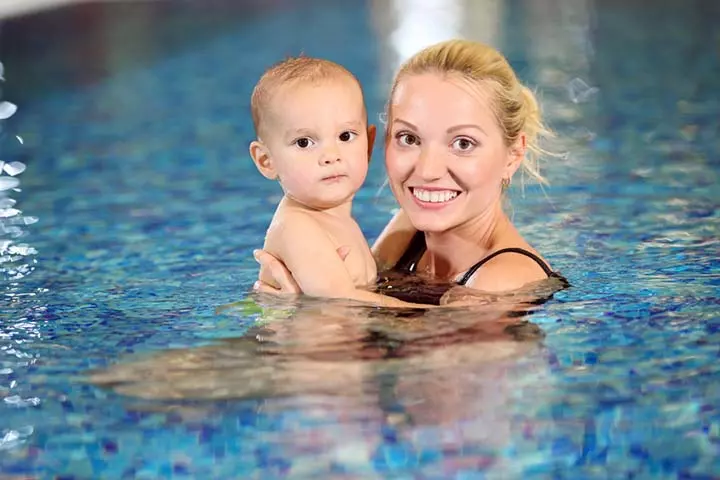
A 1-2-year-old toddler needs to first get used to the water. So, instead of directly going ahead with swimming lessons, introduce them to water. Playing games, splashing around, and singing songs can help them get comfortable. Get into the water along with them to ensure safety and have fun as well. Start communicating the safe pool habits by showing them how to enter and get out of the pool safely.
Water safety tips
- Keep the baby’s head above the water at all times. Babies are more likely to gulp a lot of water while submerged. Excess water may dilute their normal sodium levels, leading to water intoxication (7). This may cause seizures, coma, brain damage and can be fatal at times (8).
 Trivia
Trivia2. 2- to 3-year-old
A two-year-old toddler can learn to kick their legs and paddle their feet under the water. You can hold them over the water and encourage them to kick as powerfully as possible in the front and back. Teach them how to float on their stomach and back with support. Toddlers can get scared when water is on their faces, so teach them to breathe and blow bubbles underwater. Arm movements can be encouraged by adding floating toys to the water and making the tot reach for them.
Water safety tips
- Toddlers this age are curious and may get away from their parents to explore the water on their own (1). Hence it is important to keep a constant eye on them whenever water is in the vicinity. Don’t engage yourself in other activities that may distract you while watching your child (9). Just focus on holding them tight!
- Floating toys, rafts, doggy paddles, or water wings may not ensure safety while treading water. So, invest in a life jacket. Check the label to make sure it is U.S. Coast Guard approved (9). Whenever the child is on a boat, inner tube, raft, or near any water body, they should be wearing a life jacket.
- Repeatedly instill in their minds that they can only get into the water when they are accompanied by their parents. They should be taught not to run near the pool or any other water
- If the pool is not being used, toys should not be left lying around the pool and pool area (9). Toddlers may be tempted to go to the pool and reach for the toy if it is left there.
- Whenever you are at a social event, such as a party or picnic, keep an eye out for children if they are in or near any water body like the pool, ocean, lake, or river. In fact, all the parents can take turns to be the “water ocean, lake, or river. In fact, all the parents can take turns to be the “water watchers” (9).
3. 4- to 5-year-old
Around the age of four, children start to listen and follow instructions (10). They can also recollect things they learn. All these qualities are great for beginning formal swim lessons. While finalizing the class, ensure that they have professional swim instructors and there is a proper assessment system in place. The classes should allow you to watch the first one (1) or two classes to assess the swimming sessions and safety measures.
Once the training begins, they will soon be able to go into the swimming position from a standing posture and put their head underwater for a few seconds. A 4-year old child can also pick up basic swimming skills such as gliding in the water, floating, and reaching the exit (1). Coordinated leg and arm movements can be gradually developed.
Water safety tips
- The pool should be clean and well-maintained with protective gear and first aid availability. It should have clear demarcationi The process of setting a boundary or restriction for something indicating the deep and shallow ends of the pool.
- Even if a lifeguard is present, there should be one more person supervising. One guardian should always be within an arm’s distance of the child.
- Not all children progress at the same speed while learning swimming. Your child may take more time than the others, and they may have bad days too. A few little ones might get scared. Don’t force them or get angry. Let them take their time. Be patient and encouraging (10).
4. 6-year-old and up
The endurance increases at this age. Hence, six-year-olds can learn front crawl (1). They could also hold their breath underwater for longer periods and learn different stroke techniques such as the freestyle, breaststroke, backstroke, and butterfly strokes. You could team them with swimming skills such as getting an object from the bottom of the pool or jumping in the water and getting out independently.
Water safety tips
Introducing children to pool time and swimming can be a fun and exciting experience, but safety should always be your top priority. Whether you’re a parent or guardian, here are some water safety tips to create a safe environment for children in the pool.
- Always make the child swim with a buddy and keep glass bottles or containers away from the pool area.
- Visual supervision is important even if your child has already learned how to swim. However, you do not need to get into the water with them for extra safety.
- Once children learn swimming and gain necessary buoyancy skills, they might try diving. Stress the importance of diving only in the presence of an adult and only in deep water.
- Children should wear a life jacket while doing any water-based activities, such as water skiing, rafting, or boating.
- Mark the location of the breakpoint between shallow and deep water with a buoyed line and a contrasting stripe on the bottom 12 inches before the breakpoint (2).
- Once children learn to swim and gain the necessary buoyancy skills, they might try diving. Prohibit diving in shallow water, and only allow shallow-angle dives from the edge of the pool into deep water (2).
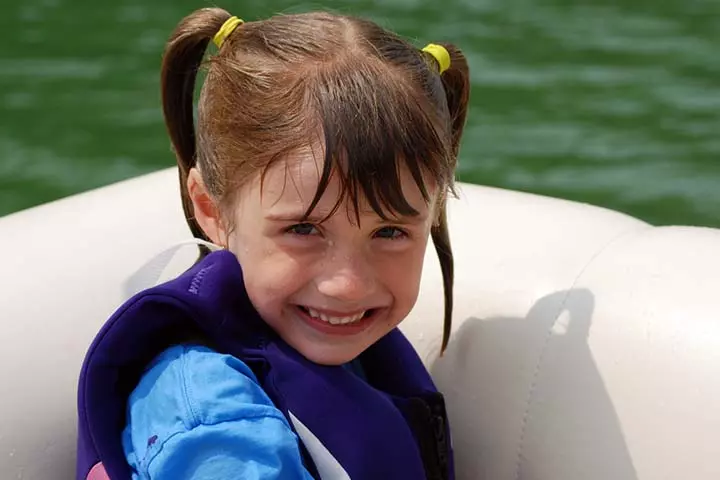
- Swimming in a pool is very different from open water. Hence, it is critical to be extra careful while taking your children near open waters such as lakes or beaches even if they know how to swim.
- Even when you cannot supervise, ensure there is a designated person to watch the water during swimming activities, and that the swimming area is free of distractions. Conduct safety drills with your child regularly.
Frequently Asked Questions
1. How should I teach a child to swim who is afraid of water?
If your child is afraid of water, find out the root cause. Try to immerse them a few centimeters at a time if they’ve agreed to give swimming a try. Only proceed with more depth if they’re comfortable. Invest in some fun equipment that could build their enthusiasm. Teach them the benefits of swimming. If your child is hesitant to swim, you may seek professional help.
2. Should I force my child to swim?
Swimming is a crucial life skill. Hence, you may use positive force to encourage your child to swim. Try to identify the root cause of their rejection. If they reject again, give them some time and try again later. Only practice gently by highlighting the importance of this aquatic activity and by building their confidence. Once they are adequately trained and equipped, you may enroll your child in school swim teams and participate in competitions.
3. How often should children practice their swimming skills?
The frequency of your child’s swimming practice can vary depending on their age, experience level, and individual needs. However, children should practice swimming skills regularly to maintain and improve their abilities.
4. Should children learn to swim in a pool or open water?
It is usually recommended that youngsters begin their swimming training in a monitored and supervised pool environment. Pools offer a regulated setting with unobstructed visibility, consistent weather, and places with varying degrees of difficulty. In swimming pools, safety precautions, including lifeguards, shallow zones, and safety gear, are typically present. In this controlled environment, instructors can closely monitor the children and offer assistance when necessary.
5. How can parents teach children to breathe while swimming?
Teaching children how to breathe while swimming is essential for their safety, comfort, and proficiency. Begin by helping your child develop breath control in the water. Next, ensure your child understands the proper body position for swimming. Introduce side breathing once your child is comfortable with breath control and body positioning.
Your kid will be more water-safe when they learn to swim. However, while deciding on ‘how to teach kids to swim,’ you can teach them yourself or enroll them in swimming lessons. But, in both circumstances, you must set some safety rules for children for their security and wellness. Even though they have learned to swim, constant supervision and guidance is necessary. Swimming classes require organization and effort, but you should also make this activity fun and enjoyable to pique their interests. Introduce fun swimming games for kids, allow them to splash around in the water, sing songs, and learn swimming at their own pace.
Infographic: How To Find The Right Swimming Instructor For Your Child?
You may be confused about which swim instructor would be the right choice for your child’s safety since you may have received numerous suggestions. So before you enroll your child in the lessons, use these questions below to ease your search and find the best instructor. Illustration: Momjunction Design Team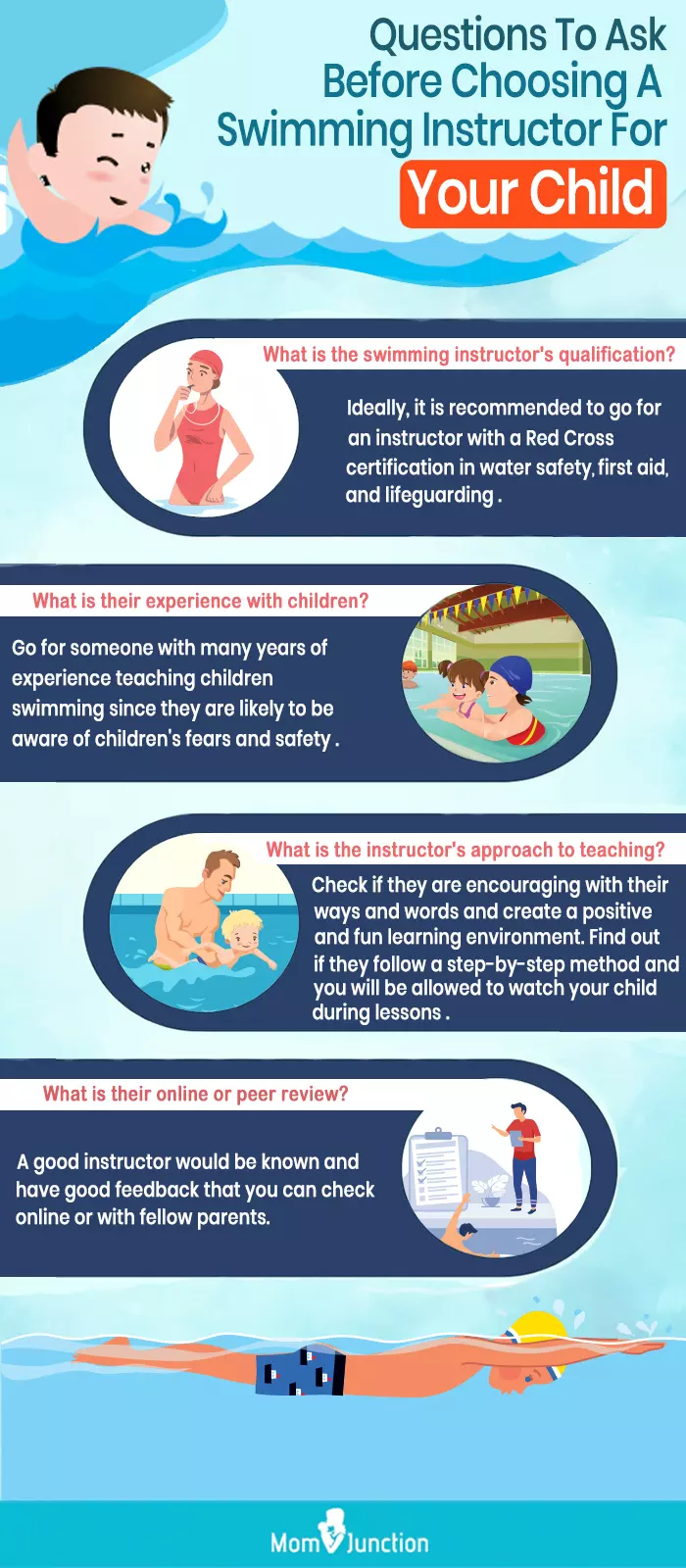
Illustration: How to Teach Your Child to Swim: A Step-by-Step Guide

Image: Stable Diffusion/MomJunction Design Team
Learn the ultimate routine to help your child learn to swim from The Bucket List Family, one of the best Family Travel Journalists out there. Their trips and tricks will make baby swim lessons fun and stress-free.
Personal Experience: Sources
MomJunction articles include first-hand experiences to provide you with better insights through real-life narratives. Here are the sources of personal accounts referenced in this article.
i. The things you need to know for your child’s first swimming lessonshttps://singaporeswimminglesson.wordpress.com/2017/02/09/things-to-know-for-your-kids-first-swimming-lesson/
ii. How do I teach my own child to swim?
https://turtleswimschoolnz.wordpress.com/2015/06/19/how-do-i-teach-my-own-child-to-swim/
References
- Swim Lessons: When to Start & What Parents Should Know
https://www.healthychildren.org/English/safety-prevention/at-play/Pages/Swim-Lessons.aspx - Swimming and Water Safety
https://www.redcross.org/content/dam/redcross/atg/PDFs/Take_a_Class/SWS_Manual_sample_2.pdf?srsltid=AfmBOopgImdfaohv7SNo0HmyfrDGJHNx_mdUeu7ClTK7vbMsMihOhTqz - Swimming Safety for Kids: Understanding the Risks of Floaties
https://usswimschools.org/swimming-safety-for-kids-understanding-the-risks-of-floaties/ - 3 tips to help kids overcome the fear of water
https://www.redcross.ca/blog/2015/3/3-tips-to-help-kids-overcome-the-fear-of-water - Learn to swim: Preparing kids for swimming lessons
https://www.swimming.org/learntoswim/preparing-kids-for-swimming-lessons/ - Swimming Safety Tips
https://www.redcross.org/get-help/how-to-prepare-for-emergencies/types-of-emergencies/water-safety/swim-safety.html?srsltid=AfmBOopNqkxeExhIgNxaHrxwSQGUf7Ko7L6dG94vBIqRdmk8OpN5qbuQ - Swimming lessons for infants and toddlers; Paediatrics Child Health (2003).
https://www.ncbi.nlm.nih.gov/pmc/articles/PMC2791436/ - Water Intoxication in Infants
https://www.stlouischildrens.org/health-resources/pulse/water-intoxication-infants - Water Safety for Children Birth to 5 Years.
https://www.seattlechildrens.org/health-safety/injury-prevention/water-safety-for-children-birth-to-5-years/#:~:text=Put%20your%20child%20in%20a - Swimming lessons: 10 things parents should know
https://www.health.harvard.edu/blog/swimming-lessons-save-lives-what-parents-should-know-201806151630 - Healthy Benefits of Swimming.
https://www.cdc.gov/healthy-swimming/about/?CDC_AAref_Val=https://www.cdc.gov/healthywater/swimming/swimmers/health_benefits_water_exercise.html - 12 benefits of swimming.
https://www.iwsfederation.com/12-benefits-of-swimming/
Community Experiences
Join the conversation and become a part of our nurturing community! Share your stories, experiences, and insights to connect with fellow parents.
Read full bio of Lenny Krayzelburg
Read full bio of Shivali Karande
Read full bio of Harshita Makvana
Read full bio of Kavita Kankani








